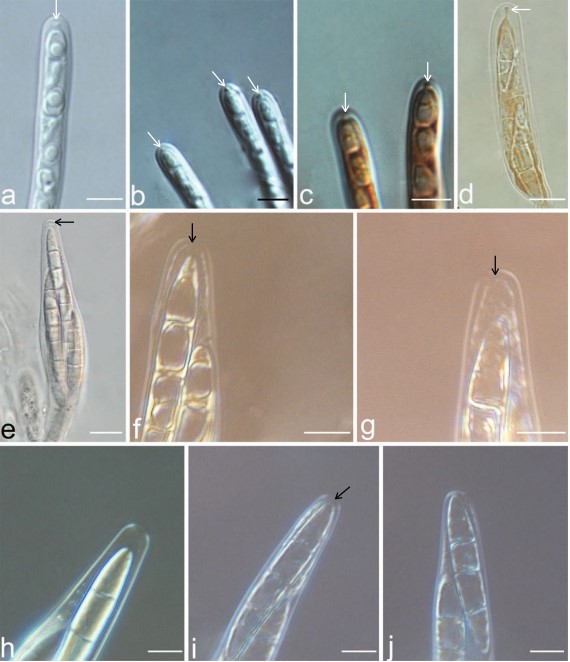Tenuitholiascus porinoides S.H. Jiang, Lücking & J.C. Wei, sp. nov.
MycoBank number: MB 570580; Index Fungorum number: IF 570580; Facesoffungi number: FoF; Fig. 1
Etymology. The specific epithet conveys the similarity with the genus Porina, although not related to the latter.
Type: China: Hainan: Changjiang county, Bawangling National Nature Reserve, 19°07′07″N, 109°09′12″E, alt. 700 m, on living leaves, 4 Sept. 2017, S.H. Jiang HN20171851 (HMAS–L0139638 – holotype).
Description: Thallus supracuticular, easily separated from the leaf surface, continuous, smooth, pale green, 3–12 mm diam, 30–52.5 μm thick. Algal partner: Phycopeltis, cells rectangular, 8–14 × 3–5 μm, composed of anastomosing filaments lying in one layer and forming regular radial plates or irregular nets. Ascomata perithecia, globose, scattered or clustered, exposed but covered by thin thallus layer up to the ostiole, central part wart-shaped, sometimes basal part broadly spreading to form horizontal plate, 0.25–0.5 mm diam and 80–150 μm high, greyish black. Involucrellum carbonized, black, 55– 125 μm thick. Exciple dense, prosoplectenchymatous, 10–12.5 μm thick, colourless to brown. Interascal filaments: unbranched or simply branched, thin. Asci bitunicate in structure, apex with a non-amyloid rounded, sometimes appearing almost unitunicate in some devel- opmental stages, due to the gradually thinner inner walls (Fig. 1f; Fig. 2h, j), clavate to cylindrical, 75–90 × 10–12.5 μm, I–, KI–, 8-spored. Ascospores fusiform, 3- septate, colourless, 25–30 × 6–8 μm. Pycnidia common, wart-shaped, immersed to erumpent, 0.05–0.1 mm diam, black. Conidia (microconidia) fusiform, hyaline, non- septate, 4–5 × 1.5–2 μm.
Alga partner. The trentepohlioid genera Cephaleuros, Phycopeltis and Trentepohlia have been reported from Strigulaceae (Lücking 2008; Nelsen et al. 2011b). In addition to morphology, four newly generated ITS sequences of the photobiont were aligned with selected Trentepohliaceae from GenBank; the selected sequences of Cephaleuros, Phycopeltis and Trentepohlia formed separate branches each (Fig. 4), and the photobiont of the new lineage clustered with Phycopeltis.
Chemistry: No substances detected by TLC.
Ecology and distribution: At present, the new species is known only from the type locality (Hainan island) in China, where it grows on leaves in wet tropical forest.
Remarks: For similarities and differences of the new species with other taxa in Strigulaceae and the unrelated genera Porina and Pocsia, see above.
Other specimens examined: CHINA: Hainan: Chang- jiang county, Bawangling National Nature Reserve, 19°07′07″N, 109°09′12″E, alt. 700 m, on living leaves, 4 September 2017, S.H. Jiang HN20171719 (HMAS–L0141342), HN20171740 (HMAS–L0141344), HN20171808 (HMAS– L0141348), HN20171820 (HMAS–L0141343), HN20171826 (HMAS–L0141349), HN20171844 (HMAS–L0141346), HN20171845 (HMAS–L0139639), HN20171850 (HMAS– L0141345), HN20171857 (HMAS–L0139640), HN20171875 (HMAS–L0141347).

Fig. 1 Tenuitholiascus porinoides (HMAS–L0139638). a Thallus. b The Phycopeltis algal partner. c Perithecia in vertical section. d Ascus (HMAS– L0139639). e Ascus (HMAS–L0139640). f Ascus apex (HMAS–L0141346). g Ascus with iodine reaction (HMAS–L0139638). h Ascus with iodine reaction (HMAS–L0141348). i Ascospores (HMAS–L0139639). j Ascospores (HMAS–L0139638). Scale bars: a = 300 μm, b = 10 μm, c = 20 μm, d, i, j = 10 μm, e–h =5 μm

Fig. 2 Strigula nitidula (HMAS–L0139358): a–b Ascus. c Ascus showing iodine reaction in Lugol’s solution. Strigula cf. smaragdula GD2015025–5 (HMAS–L0138067): d Ascus showing iodine reaction in Lugol’s solution. Tenuitholiascus porinoides (e–g HMAS–L0139638; h–j HMAS–L0141348) e Ascus. f–g Ascus with iodine reaction in Lugol’s solution. h Ascus. i–j Ascus with iodine reaction in Lugol’s solution. White arrows indicate the ocular chamber, and black arrows indicate the non-amyloid dome. Scale bars: a–c= 5 μm, d = 10 μm, e–j=5 μm

Fig. 4 Phylogenetic tree constructed from Bayesian analyses based on ITS of photobionts of Trentepohliaceae. Bayesian posterior probabilities (B– PP) > 90%, and Maximum likelihood bootstrap proportions >50% are shown at nodes (B–PP / ML–BP). The new sequences generated in this study are in bold, and algal partners from Tenuitholiascus porinoides are marked with *
